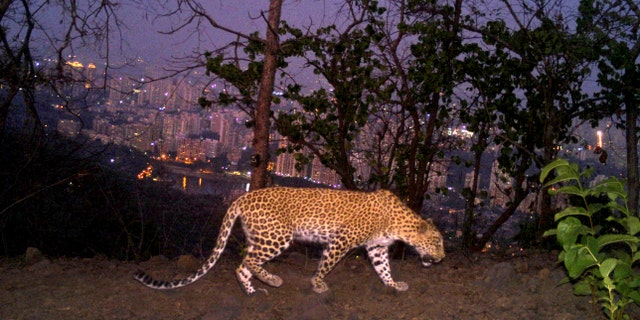los-angeles” target=”_blank”>Los Angeles<
“In the future, there’s going to be more cities like this, as urban areas further encroach on natural habitats,” said biologist Audra Huffmeyer, who studies mountain lions at the University of California, Los Angeles. “If we want to keep these large carnivores around on the planet, we have to learn to live with them.”

A leopard is seen walking across a ridge in Aarey colony near Sanjay Gandhi National Park overlooking Mumbai city, India.
(Nikit Surve, Wildlife Conservation Society – India/ Sanjay Gandhi National Park via AP)
Freeways and Fragmented Habitat
Twenty years ago, scientists in Los Angeles placed a tracking collar on their first cat, a large male mountain lion dubbed P1, that defended a wide swath of the Santa Monica Mountains, a coastal range that lies within and adjacent to the city.
“P1 was as big as they get in us-regions, about 150 pounds,” said Seth Riley, a National Park Service ecologist who was part of the effort. “These dominant males are the ones that breed — they won’t tolerate other adult males in their territory.”
With GPS tracking and camera traps, the scientists followed the rise and fall of P1’s dynasty for seven years, through multiple mates and litters of kittens. “2009 was the last time we knew anything about P1,” said Riley. “There must have been a fight. We found his collar, blood on a rock. And never saw him again. He was reasonably old.”
Since then, Riley has helped collar around 100 more mountain lions in Los Angeles, building a vast database of lion behavior that’s contributed to understanding how much territory the cats need, what they eat (mostly deer), how often they cross paths with people and what may imperil their future.
As with medieval European kings, the biggest threat turned out to be inbreeding. Living in small territories separated by highways has caused some males to mate with daughters and granddaughters, who weren’t able to naturally disperse farther away. That’s led to genetic problems such as fertility issues and kinked tails.
“Based on genetic analysis, we know that P1 mated with P6, his daughter – that was the first case we documented of this very close inbreeding,” said Riley.
Leopards in Urban Landscape
In Mumbai, one of the world’s most densely populated cities, the leopards are packed in, too: about 50 have adapted to a space ideally suited for 20. And yet the nocturnal cats also keep mostly out of sight.
“Because these animals are so secretive, you don’t know much about them. You can’t just observe them,” said Vidya Athreya, director of Wildlife Conservation Society in India and part of a research team that recently fitted five leopards with tracking collars.
The leopards’ core range is centered around Sanjay Gandhi National Park, a protected area boxed on three sides by an urbanized landscape, including a neighborhood that’s home to 100,000 people and nearly a dozen leopards.
HOUSE PASSES ‘TIGER KING’ BILL TO OUTLAW PRIVATE OWNERSHIP OF BIG CATS
Researchers tackled specific questions from park managers, such as how the cats cross busy roads near the park.
To get the answer, they collared a big male dubbed Maharaja. They found that it walked mostly at night and traversed over 60 kilometers (37 miles) in about a week, from the park in Mumbai to another nearby. The leopard crossed a busy state highway, using the same spot to pass, on three occasions. It also crossed a railway track.
The path chosen by Maharaja is nearby a new highway and a freight corridor under construction. Researchers said that knowing the big cats’ highway crossing habits can help policymakers make informed decisions about where to build animal underpasses to reduce accidents.

A mountain lion eats a kill at Santa Monica Mountains National Recreation Area near Malibu Creek State Park.
(National Park Service via AP)
Living Alongside Big Cats
In Los Angeles, long-term mountain lion research showing the harm of fragmented habitat helped fuel a successful campaign to build a wildlife crossing bridge over U.S. Route 101, one of the city’s busiest freeways. Construction began on April 22.
When it’s finished in three years, the bridge will be covered in native plants and include special sound walls to minimize light and noise disturbances for nocturnal animals. It will connect Santa Monica Mountains and Simi Hills, enlarging the dating pool for resident mountain lions.
But learning to live alongside cats is not only a matter of infrastructure decisions, but also human choices and education.
TIGER KING ZOO LOSES THE LAST OF ITS BIG CATS AFTER FEDERAL RAID
When Athreya first started advocating for co-existence with Mumbai’s leopards, she was met with skepticism and pushback from other biologists and policy makers. They thought it would be impossible for big cats to live alongside people without significant friction, or worse.
“The dominant narrative was about conflict,” she said. But she helped push the conversation to be about “negotiations, improving the situation for both wildlife and people.”
That is not to say living alongside a big predator is without perils. In Mumbai, Purvi Lote saw her first leopard when she was 5, on the porch of a relative’s home. Terrified, she ran back inside to her mother. But now the 9-year-old says she isn’t as afraid of the big cats.
Like other children, she doesn’t step outdoors alone after dark. Children and even adults travel in groups at night, while blaring music from their telephones to ensure that leopards aren’t surprised. But the most fundamental rule, according to the youngster: “When you see a leopard, don’t bother it.”

A mountain lion is seen "cheek-rubbing," leaving her scent on a log in the Verdugo Mountains with Glendale and the skyscrapers of downtown Los Angeles.
(National Park Service via AP)
Avoiding deadly conflicts
wild-nature” target=”_blank”>Leopards in Mumbai<
Both cities have learned that trying to capture, kill or relocate the cats isn’t the answer.
“Relocation and killing makes conflict worse,” said Beth Pratt, California regional director at National Wildlife Federation. “It’s better to have a stable population, than one where hierarchies and territories are disrupted.”
Avoidance is the safest strategy, she said. “These big cats are shy — they tend to avoid human contact as much as they can. They’re really extreme introverts of the animal kingdom.”









